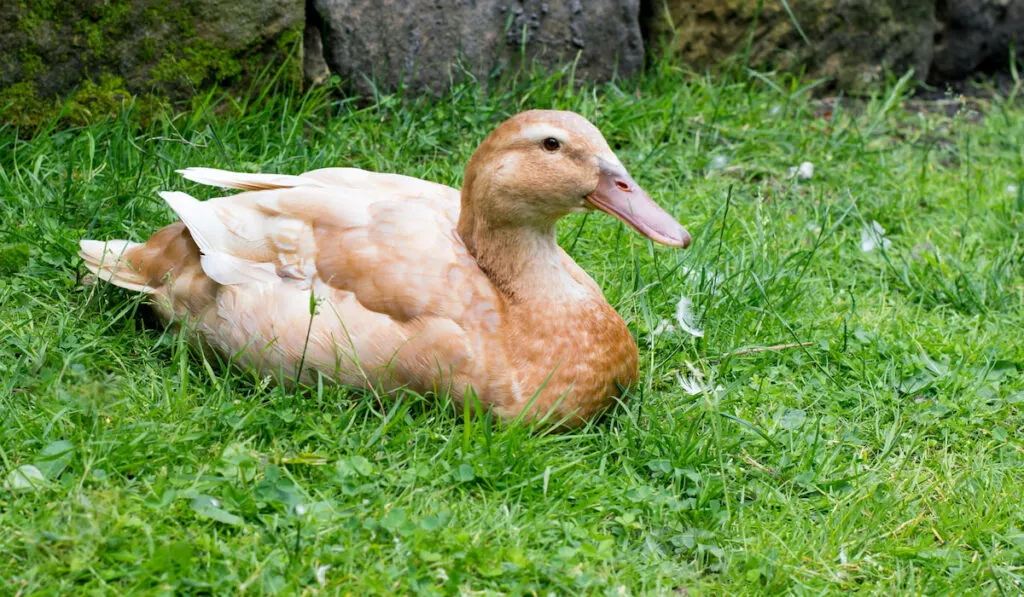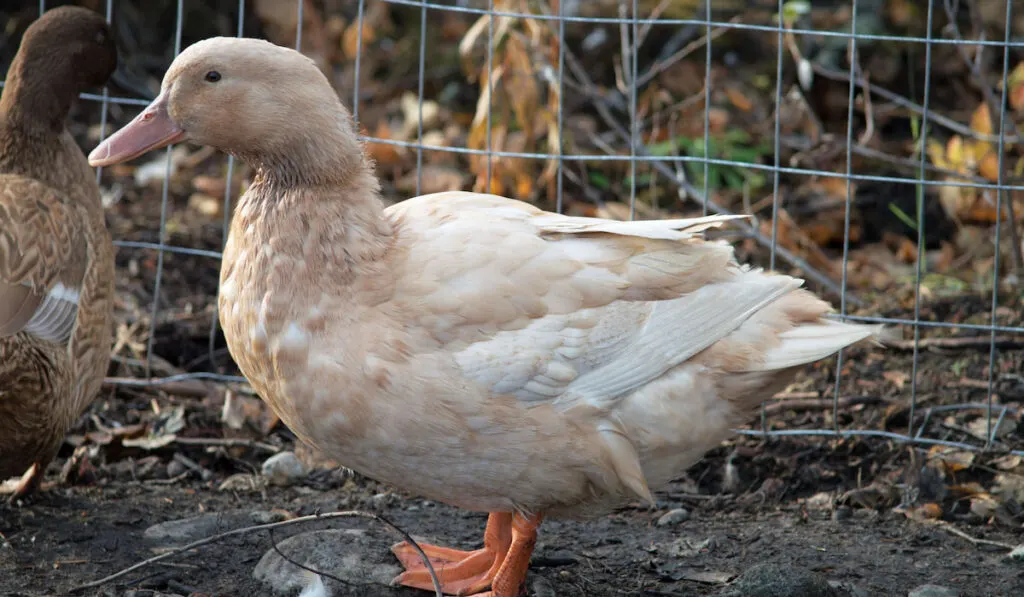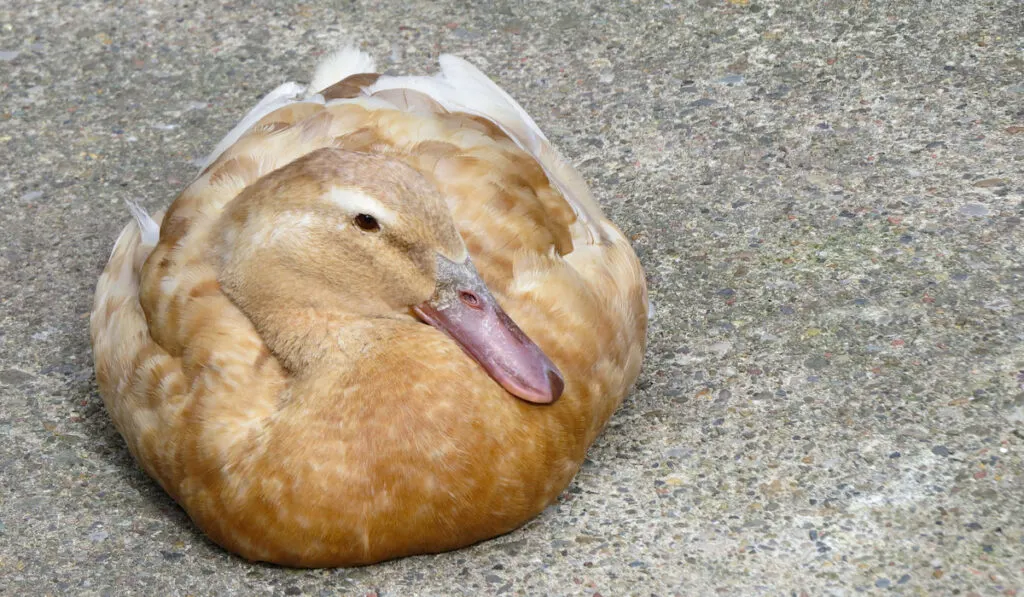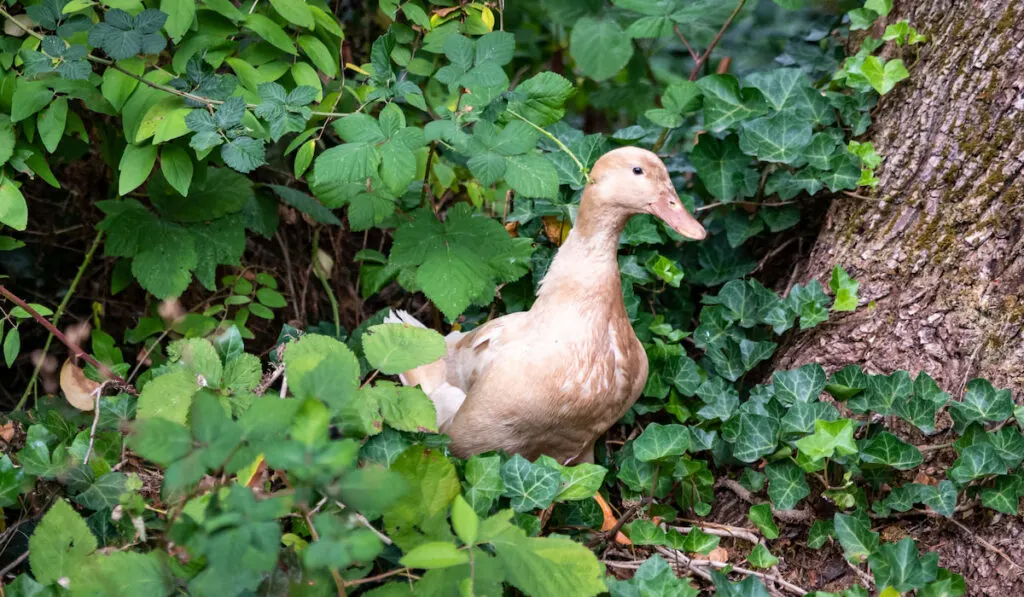Are you looking for a duck breed that is as appealing as it is intelligent and consistent in egg and meat production? Look no further than the Buff duck, also known as the Orpington duck.
The birds are also compassionate pets thanks to their calm and friendly disposition. Read on for a better understanding of this dynamic duck breed.
Table of Contents
History
The Buff duck, or Buff Orpington duck, is a general-purpose duck breed originating in England. As the name suggests, William Cook first developed the breed in Orpington, England.
William Cook crossed the Rouen, Indian Runner, Cayuga, and commercial Aylesbury breeds to develop a buff-colored duck breed when there was a roaring demand for buff color patterns.
The Buff Orpington duck breed gained traction after its introduction to the public in 1870.

In 1908, Cook introduced the Buff Orpington ducks to New York City in the United States. Four years later, the American Poultry Association Standard of Perfection acknowledged the ‘Buff Duck’ in 1914.
This was quite an unusual labeling by the American Poultry Association as it may be the only instance where a breed is listed only by color.
On the other hand, The British Poultry Standard accepted the Orpington duck breed in 1910. By 2011, North America had up to 793 breeding buff ducks and 11 Buff duck breeders.
Appearance
The Buff Orpington duck is as beautiful as it is functional as a general-purpose duck breed.
Buff ducks have perfectly oval heads, medium-sized beaks, and long, curved necks. Their bodies are broad, long, and deep, which allows them to pack a decent amount of meat for meat production.
As their name suggests, Orpington drakes and ducks have buff plumage and orange-yellow or amber shanks and feet. Drakes have yellow bills, while the females’ bills are brown-orange.
Though Buff ducks have a reddish undertone, it is evenly distributed, leaving no penciled, white, or gray feathers.
What’s more, drakes have glossy upper necks and brown heads. This color ends in a sharp line around the neck with minimal blue on their rumps and no traces of green hues.
Lastly, Buff ducks have small but well-curled tails and short wings.

Size
Buff ducks are medium-sized ducks weighing between 5 and 8 pounds.
Moreover, both male and female Buff ducks tend to gain weight and mature quickly. They can reach butchering weight in as few as 8 to 10 weeks. This makes them an excellent option for meat ducks.
Ducks generally weigh between 5 and 6 pounds, while drakes weigh between 6.5 and 8 pounds upon maturity.
Egg Production
Buff hens are decent and consistent egg layers, making them an excellent choice for an egg-producing duck breed.
Upon reaching maturity, Orpington hens can consistently lay 3 to 4 eggs per week, making that 180 to 245 eggs annually.
Their large eggs are usually white but can occasionally be tinted, with each weighing 2 to 3 ounces (80 to 90 g).
Besides being commendable egg producers, Buff hens are highly broody birds and excellent sitters.
However, while the hens will gather and claim unattended eggs when broody, investing in an incubator is vital if you want to grow your flock.
All in all, Buff Orpington ducks are great mothers to their young. They are protective and relentlessly watch over their young while teaching them how to forage in water and on land.
Meat Production
Traditionally, Buff Orpington ducks were raised for commercial meat production, but not so much anymore.
This is regardless of their broad bodies that pack a decent amount of meat and that they gain weight and reach butchering weight in just 8 to 10 weeks.
That said, people who have tried Orpington duck meat maintain that it is superior to the meat produced by Pekin ducks.
What’s more, Buff ducks dress out exceptionally well because their pin feathers do not leave spots on the carcass.
Temperament
Orpington ducks are among the most friendly and sociable duck breeds you will encounter.
Due to their relaxed demeanor, they effortlessly blend in with other flock members, which reduces fights and bullying.

Their friendliness also enables them to get along with people and other livestock—no wonder they make excellent pets for children and adults.
They are also among the quietest duck breeds for noise-conscious neighbors and poultry owners. They make great pets but need ample space to free-range and forage.
Buffs are also curious and highly intelligent. They explore their environment through free-ranging whenever they are allowed to. Foraging for greens is one of their favorite activities.
If you do not have enclosures where they can safely roam, their high intelligence is handy because you can easily train the ducks on their free-range boundaries.
When it comes to companionship, drakes are loyal to the hens and diligently watch over the flock when out free ranging.
Lifespan
Buff Orpington ducks are a domesticated breed — they live in comfort and safety with unlimited access to clean water and plenty of food.
Under such ideal conditions, Buff ducks can live for 8 to 12 years. That said, certain factors like disease and parasites can negatively impact this lifespan range, hence the need to deworm them regularly.
Other issues like poor diet, loneliness, and stress can shorten your Buff ducks’ lifespan. Similarly, Buff ducks’ lifespans are significantly reduced in the wild due to disease, hunger, and predators.

Nutrition
Like other duck breeds, Orpington ducks are exceptional foragers and usually make up for a large chunk of their daily food requirements by foraging some of their favorite bites like:
- Tadpoles
- Slugs
- Mosquitoes
- Snails
- Small lizards
- Crustaceans
- Wild greens
- Worms
- Small fish
- Weeds
- Seeds
- Insects
With this in mind, owners can use commercial feed to supplement the Buffs’ forage to satisfy their nutritional needs. Fruits and vegetables should also be offered as treats throughout the day.
Remember that ducks should also have access to sand or gravel to eat when needed to support their digestive systems.

Housing
Besides having an enclosed duck house to seek shelter from the elements, Orpington ducks also need a fenced or shielded area to safely free-range and roam in.
Regarding shelter, the coop interior should provide each bird with at least 4 square feet of floor space.
If you choose to go for an enclosure like a run, remember to offer each Buff duck at least 10 square feet to roam freely. The more space the birds have to roam, the happier they will be.
Lastly, Buff ducks will happily live and thrive in small backyards or homesteads as long as they have access to a safe, spacious, clean coop and run with a water feature.
Luckily, a hand-dug pond, small water tub, or baby pool is enough to provide the water they need to play, swim, clean and cool themselves in.
Otherwise, your Buff ducks may overheat, especially during the hotter months.
Final Thoughts
Is the Orpington duck a worthy addition to your existing flock? Yes! It should be. From packing a decent amount of meat to consistent egg production and being hardy, you can never go wrong with a Buff duck flock.
However, whether Buff ducks are good for you comes down to what you want and what you are willing to offer.
